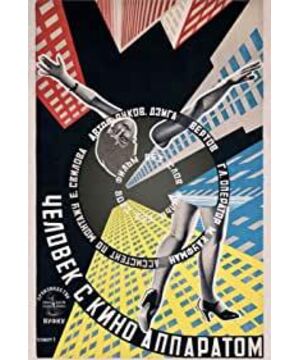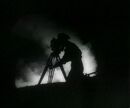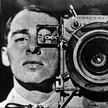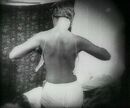As Vertov's most representative work, this film deserves to be a representative work of the "movie eye" theory.
The film begins by simulating the opening screening of the movie theater (using the camera to simulate the audience's eyes, and the clip is like the audience's scrutiny of the movie theater after entering the movie theater) to give the audience a warm sense of substitution. Then, the theme of the first chapter, "Sleeping Soviet Union", begins with a silent street scene, stagnant industry, and various sleeping people.
But in this almost depressing clip, accompanied by a wake-up call of a tight whistle, a train came at high speed, and then the whole city woke up.
It is worth mentioning that, compared with the length of the early morning segment of Berlin: Urban Symphony, which is similar in structure, Vertov seems to have deliberately emphasized that the depressing street scene and environment in the early stage actually have some kind of ideological externalization. of. At that time, 1929 was in the midst of the world economic crisis, and the whole of Europe fell into an atmosphere of depression and depression, while the Soviet Union was enjoying a great economy due to the implementation of a planned economy. Therefore, expanding the previous segment is like exposing the shortcoming of capitalism, and then exaggerating the economic status quo of the Soviet Union. This point is similar to the portraits of Lenin and Marx at the end of the film, because the essence of the Soviet-Russian montage school was born for political propaganda. Therefore, for Vertov, film is only an artistic "propaganda weapon". As the opening line of the film "aims to create a truly international absolute film language", it is also the same view supported by the Marxist film theorist Balaz Bella in "The Seeing Man".
But as far as artistry goes, the montage of blinking eyes and shutters opening and closing in the closing part of the first chapter is a classic.
The second chapter, like "Berlin: Urban Symphony", starts with the representatives of various heavy industrial creations (airplanes, automobiles, trams), and then goes to the progress of industrial equipment and workers' labor, forming an "industrial march". , and then the vitality of the entire Soviet society. In the final chapter, the rhythm is slowed down and the combination of static photos and hand-shaking sounds, from movement to stillness, from society to individual, to connect the opening of the third chapter.
The third chapter begins with static and dynamic representations of "people in the city", and uses marriage, divorce, death, funerals, childbirth, weddings, and moving crowds (up and down the elevator, in and out of the phone booth, and in and out of the hall. This episode also appears In "Berlin: Urban Symphony") to show the trajectories of people in social life, and then zoom in to the rapidly changing city with quick editing of eyes and landscapes, and use this as the keynote through the ambulance and The fire brigade who dispatched the police to fight the fire showed the relationship between the city and the people and the vitality of the city.
In "Berlin: Symphony of the City", Walter Rutmann synthesizes the fourth and fifth chapters of "The Man with the Camera", which combines the socio-economic situation (such as the way of trade, the state of merchants and citizens, etc. ) and the trajectories of the crowd, as capitalism in 1927 was in a period of relative stability, but behind the prosperity there were harbingers of crisis (e.g. the old beggar picking up cigarette butts, the repressed man in Berlin: Urban Symphony) The diving woman, the mother who can't afford to eat and his two children, and the phone calls that have been beaten countless times in the financial industry and the stock traders who bark like a monkey and a dog all permeate the harbinger of such a crisis), so the overall social outlook Cover up the essence of people's life. Therefore, Vertov separates these two points, so that it has the characteristics of a "propaganda weapon", laying out the facts and showing you the real scene, which can better reflect the superiority of his system.
As a result, Chapter 4 slows down the rhythm to "The Appearance of All Beings at Work", and then speeds up the rhythm to compose a "labor hymn" like the previous "Industrial March", with the rushing water and high-speed industrial equipment Edited together to describe its never-ending industrial civilization.
The fifth chapter is silent, and like "Berlin: Urban Symphony", it shows the rich leisure activities of the Soviet people (the beach, the magician in the Chinese gown, the merry-go-round, sports, etc.), and then leads to the sixth chapter. nightlife.
And in Chapter 6's Nightlife, Vertov presents a nightlife with a moral framework (because in Act 5 of Berlin: Urban Symphony, after a young man and a woman get into a taxi, the next shot turns to "HOTEL", this design also has an explicit component of the traditional moral crisis in European society after the First World War), cinema (people watch Soviet films, such as the poster of the Soviet film "A Woman's Awakening" that appeared many times, and in In "Berlin: Urban Symphony", Rutmann vaguely photographed Chaplin's feet, which is also the epitome of the invasion of Hollywood film culture after World War I, while Vertov confidently displayed Soviet culture), beer hall (Unlike the beer hall in "Berlin: Urban Symphony", which is a place where the poor gather to express their emotions, the pub in Vertov's lens is like an entertainment place for drinks and leisure. Suppression and dissatisfaction), clubs (the club in Vertov’s lens does not have any dance, but is more like a chess hall where gentlemen play games) and theater (compared to “Berlin: Urban Symphony”, which is more inclined to civilian culture The vulgar drama, Vertov pays more attention to reflect the high culture of the Soviet Union).
And when the camera turns to Lenin, the soundtrack also becomes The Internationale. With the change of the soundtrack, the film began to clearly reveal the ideology, such as "Lenin Club, the Soviet Union's First Five-Year Plan" and so on. Shooting Nazi targets and knocking down the Nazi base camp was once more like a direct connection to Berlin: Urban Symphony, reflecting the superiority of socialism (especially the superiority of the planned economy) through different representations of the same structure. In the end, multiple sounds were combined into a train whistle that woke up the Soviet Union at the end of the first chapter and returned to the theater.
At the end of the film, a camera that is full of life like "Transformers" is a symbol of "movie eye"; while facing the plane in the sky, "reconnaissance shooting" with a camera like a "large artillery" is a symbol of "movie eye". More of a "propaganda weapon".
In addition, the film also restores the recording process of the image with the existence of the "photographer" in the way of "self-exposure", reflecting its authenticity, and also shows the audience how the camera records life like the eyes.
Therefore, this film not only shows the vitality of the Soviet economy and the Soviet society under the European economic crisis on the surface, but also restores the shooting process and its authenticity based on the theory of "movie eye", and also plays an ideological role. The efficacy of propaganda weapons" can be called the peak work of the "movie eye school" in the Soviet-Russian montage school.
View more about Man with a Movie Camera reviews







